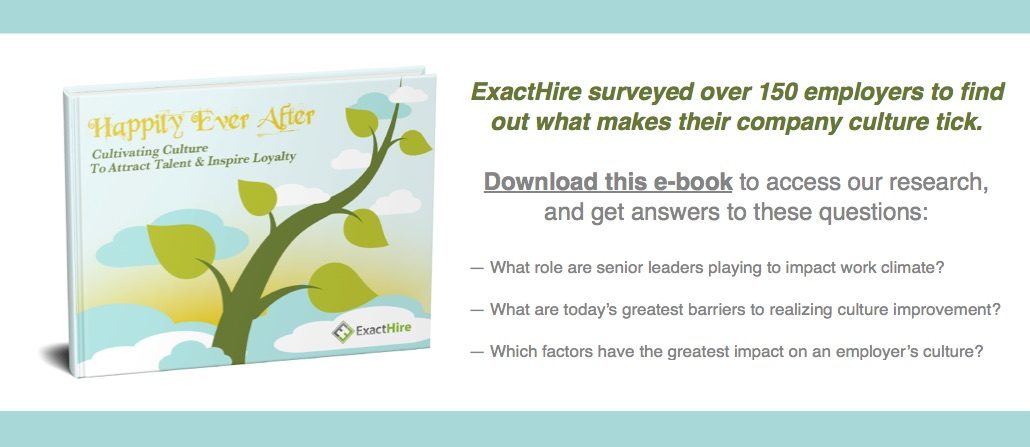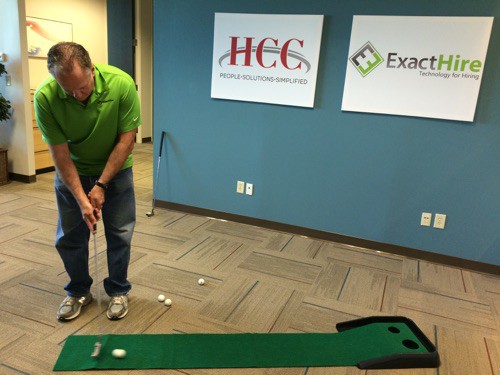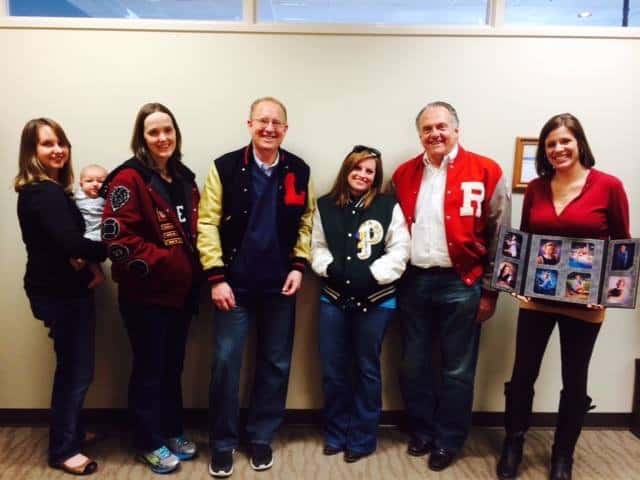11 Small Business Tips for an Epic Annual Meeting
I enjoy working in the small- and medium-sized business (SMB) space–it’s easy to relate to challenges and opportunities for these employers because I work for an SMB, myself. Having access to impact the entire business from wherever I stand within the organization is an empowering benefit, too. One of my favorite instances of this benefit is the annual ExactHire company meeting. While we do meet as a team on a monthly basis, the annual meeting enables us to retreat off site and do a deep dive into the state of the organization, our long-term product road map and our business strategy.
Having at least six of these yearly meetings under our belt now, I can say we’ve definitely improved our efficiency and meeting outcomes over the years. In this blog, I’ll share our tips for holding an epic annual company meeting to help propel your business forward.
1 – Location is everything
The easy, predictable thing to do is to just have your annual meeting in your own conference room. However, there is something exciting and liberating about changing your venue and assembling in a new space. Yesterday, we were lucky enough to occupy an ultra cool space at the Hotel Tango Artisan Distillery in our hometown, Indianapolis. It was my first time there and it was an excellent space for getting our brainstorming juices flowing and stepping outside the box.
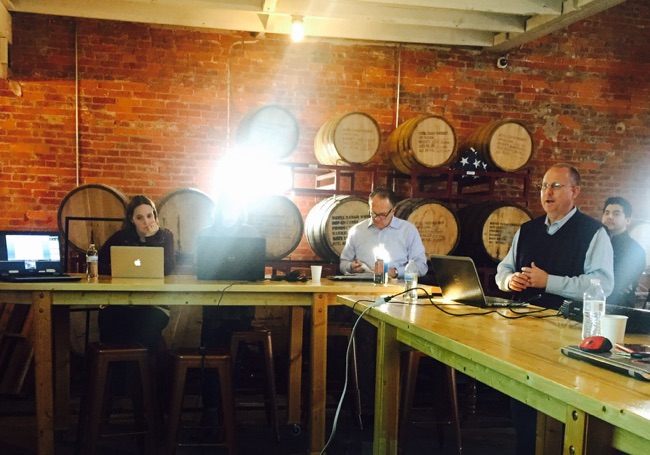
Hotel Tango was a great, unconventional space – don’t mind Christa’s angelic illumination!
When you select a venue for your meeting, be sure and consider the needs of your employees when it comes to things like accessibility and atmosphere. Do you want somewhere quiet or somewhere full of action and visual stimulation? When I stepped into Hotel Tango, I was reminded of the grain bins and silos on the farm where I grew up…but in a good, nostalgic way. Of course, that’s par for the course at a distillery! Additionally, we took breaks here and there to allow the distillery staff to attend to their spirits and open up the garage door to operate the forklift. Nevertheless, the shiny copper pieces on the stills and the illuminated string lights within the exposed brick building provided creative ambience for our session.
2 – Provide an agenda and assign some homework
What you get out of your corporate meeting will be dependent upon the amount of effort you put into preparing for it–and not just the organizer, the whole team, too. Our Co-Founder, Jeff Hallam, sent a thorough agenda of meeting topics more than a week in advance of our meeting. Additionally, he assigned the entire company the “homework” of thinking about how to answer three primary questions that were tied to our overall short-term objectives of growing revenue and improving profitability.
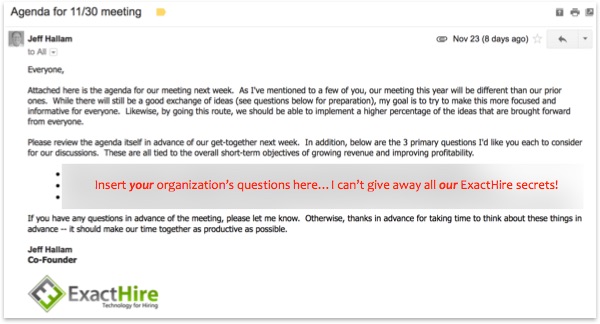
By asking your team to think about solutions in advance, they are more engaged with the discussion topics and likely to be prepared to contribute to the discussion during the meeting. Remember to keep your homework assignment short–having too many to-dos not only dilutes the effectiveness of any one potential solution, but will also most certainly guarantee that you run out of time during the meeting.
3 – Don’t forget the coffee
And snacks are good, too. Our meeting ran from 9am – 1pm, so while people had the opportunity to eat a normal breakfast at home, we still provided fruit/dip and plenty of hot coffee, creamer and sugar. The coffee was of course key to not only our mental stimulation, but also a source of warmth for a few of us while the distillery garage door was open to allow forklift entry. We stayed cozy though!
Also, be sure to take into account any dietary restrictions present among your team members. For example, have some gluten free and/or meatless options available, if applicable, for your organization’s employees.
4 – Make a ruling on electronic device access
At ExactHire, we live on our electronic devices which comes as no surprise since we are in the SaaS product space. I can’t remember the last time I actually printed or filed something in a cabinet. However, having everyone glued to their laptops and/or tablets during a team meeting isn’t always productive as it becomes easy for people to be distracted by email, caught up in IM, etc. It really depends on the purpose of your meeting and whether you need to collectively view or update items electronically during the meeting.
NOTE: It is a good idea to have access to a projector so that everyone can look at a screen together to discuss items.
5 – Designate an official note taker
Especially if you decide that the majority of people will not be using their computer during the meeting, make sure that one person is the official recorder of all important discussion topics and action items. The last thing you want is for all your glorious ideas to be forgotten a week after the meeting.
The notes should be sent out promptly (within one business day) of the conclusion of the meeting. I was our note taker for yesterday’s meeting and opted to bold some of the more compelling team ideas, as well as highlight specific action items (and their owner) in yellow on the notes.
6 – Encourage a variety of presenters
Because annual company meetings tend to be longer than the average monthly update, it would get pretty tedious for the same person to speak the entire meeting. While Jeff and Harlan (our other Co-Founder) did speak quite a bit at the start of the meeting, they also called on many other teammates throughout the discussion to provide a deeper explanation of their own projects.
The extent to which this is successful in your organization will depend on the personalities of individuals (are they comfortable speaking in front of a large group), as well as the extent to which candor is valued within the business. While everyone cannot provide an overview, many can ask questions and probe for greater context within a culture that challenges assumptions and welcomes inquisitiveness.
7 – Have a parking lot…literally and metaphorically
While nearby parking is ideal for your meeting, what I mean by “parking” is designating topics that get into the weeds as something to table and discuss later–put them in the “parking lot” to handle at a future date.
To do so, add them to an easel chart, whiteboard and/or shared file and assign an owner to make sure they aren’t forgotten later. To avoid hurt feelings when one person’s passionate about hashing out a topic, set expectations at the start of the meeting that, at times, some items will have to be put on the back burner in order to get through the entire meeting agenda in a timely fashion. Pass the conch shell, if you will, and move on to the next item.
8 – Don’t forget to order lunch in advance
It’s a nice gesture to order your team lunch during the annual company meeting. We enjoyed some delectable dishes from Chilly Water Brewing Company during our retreat yesterday…conveniently located right next to Hotel Tango.
In past year’s meetings, we didn’t always have the foresight to order our meals before or early on during the meeting, and therefore found ourselves scrambling to figure out food options right at lunchtime. This resulted in waiting a long time to eat and delaying the meeting.
9 – Take pictures
Especially if you head to an eclectic off site location, be sure and snap some memorable photos of the team and what you accomplish during the day. Photographs of events like these are great for inclusion on your branded company careers page, on company social media profiles, around the office and maybe even in an annual holiday video. They just might inspire a blog related to company culture and procedural effectiveness, too.
10 – Respect everyone’s time
Significant, every great once-in-awhile company meetings are typically long already. Make sure you don’t extend discussion beyond the official stop time. If you do, you not only may delay employees’ ability to make other engagements already planned (e.g. sales demos, picking up kids, etc.), but you also will likely forfeit the attention space of those that remain–even with coffee.
Speaking of respecting time, make sure you start your meeting on time, too. A prompt start time is key to a prompt stop time. If this is a struggle within your corporate culture, set the expectation clearly in the agenda email that is sent in advance.
11 – Post-event check in
The work will have only just begun at the conclusion of your corporate meeting. Even when the notes are sent and action items are marked, your leadership team should be sure and schedule milestones to check in with the team and make sure that each task owner is accountable to moving his/her action item(s) forward. This is a great opportunity to offer assistance, vet new questions and schedule follow-up discussion for items that were placed in the parking lot, too.
I hope these tips help you plan an invigorating annual company meeting. While you can’t anticipate every single need or detail, you’re already ahead of the game if you are providing a special opportunity to engage your team and move the business forward–together.


